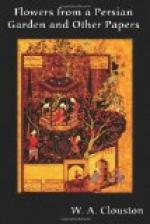Then Allah caused to be raised up for Adam a magnificent pavilion, or temple, constructed entirely of rubies, on the spot which is now occupied by the sacred Kaaba at Mecca, and which is in the centre of the earth and immediately beneath the throne of Allah. The forlorn Eve—whom Adam had almost forgotten amidst his own sorrows—in the course of her weary wanderings came to the palace of her spouse, and, once more united, they returned to Ceylon. But Adam revisited the sacred pavilion at Mecca every year until his death. And wherever he set his foot there arose, and exists to this day, some city, town, or village, or other place to indicate the presence of man and of human cultivation. The spaces between his footsteps—three days’ journey—long remained barren wilderness.
On the twentieth day of that disorder which terminated the earthly existence of Adam, the divine will was revealed to him through the angel Gabriel, that he was to make an immediate bequest of his power as Allah’s vicegerent on earth to Shayth, or Seth, the discreetest and most virtuous of all his sons, which having done, he resigned his soul to the Angel of Death on the following day. Seth buried his venerable parent on the summit of the mountain in Ceylon ("Adam’s Peak"); but some writers assert that he was buried under Mount Abu Kebyss, about three miles from Mecca. Eve died a twelvemonth after her husband, and was buried in his grave. Noah conveyed their remains in the ark, and afterwards interred them in Jerusalem, at the spot afterwards known as Mount Calvary.
* * * * *
The foregoing is considerably abridged from An Essay towards the History of Arabia, antecedent to the Birth of Mahommed, arranged from the ‘Tarikh Tebry’ and other authentic sources, by Major David Price, London, 1824, pp. 4, 11.—We miss in this curious legend the brief but pathetic account of the expulsion of Adam and Eve from the Garden of Eden, as found in the last two verses of the 3rd chapter of Genesis, which suggested to Milton the fine conclusion of his Paradise Lost: how “some natural tears they dropped,” as the unhappy pair went arm-in-arm out of Paradise—and “the world was all before them, where to choose.” Adam’s prolonged residence at the top of a high mountain in Ceylon seems to be of purely Muhammedan invention; and assuredly the Arabian Prophet did not obtain from the renegade Jew who is said to have assisted him in the composition of the Kuran the “information” that Allah taught Adam the mystery of working in iron, since in the Book of Genesis (iv, 22) it is stated that Tubal-cain was “an instructor of every artificer in brass and iron,” as his brother Jubal was “the father of all such as handle the harp and the organ” (21).—The disinterment of the bones of Adam and Eve by Noah before the Flood began and their subsequent burial at the spot on which Jerusalem was afterwards built, as also the stature of Adam, are, of course, derived from Jewish tradition.




